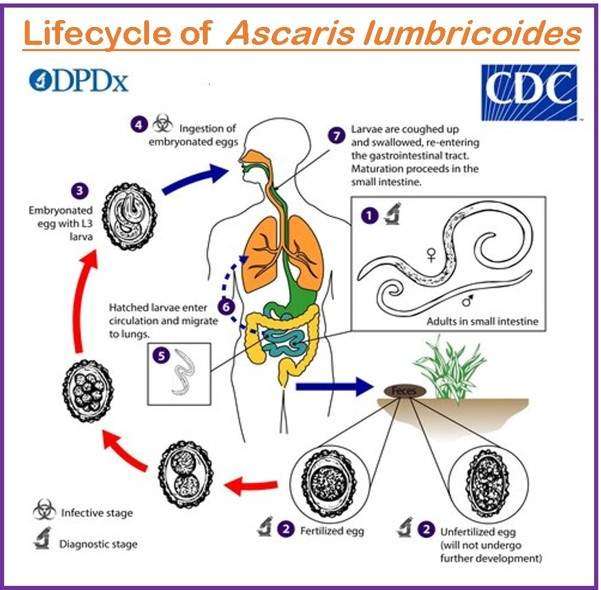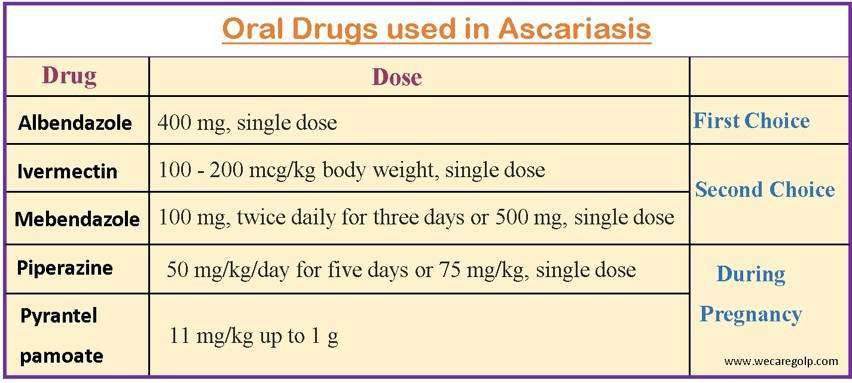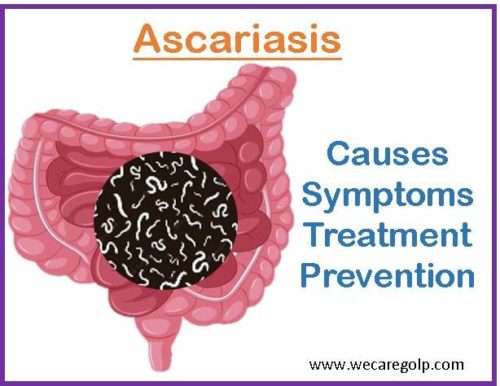Introduction
Ascariasis is a human parasite infection caused by Ascaris lumbricoides, which is a roundworm with a cylindrical appearance. It is one of the most significant NTDs (neglected tropical diseases). When embryonated eggs from contaminated soil, food, or water are accidentally consumed, transmission happens.
It has an aggregated or over-dispersed distribution, with most of the people carrying light infections and a relatively small percentage of the population carrying serious infections. The pattern of reinfection, or propensity, in people, is also consistent. Especially in impoverished nations with subpar sanitation and hygiene standards, it is one of the most widespread parasitic illnesses.
Adult Ascaris worms can reach a length of 30 centimeters (12 inches) and are found in the small intestine. They multiply by laying a lot of eggs, which are then passed through infected people’s feces. Ascaris eggs are hardy and capable of lasting a long time, especially in warm and humid environments. The infection cycle continues when a different person consumes the infectious eggs.
Ascariasis is more common in tropical and subtropical areas, especially in developing nations with poor sanitation systems. The implementation of health education initiatives to increase awareness of transmission and prevention, better sanitation and hygiene standards, and increased access to clean water are the major preventive interventions to minimize the disease.
Incidence
- The World Health Organization (WHO) estimates that A. lumbricoides is present in more than 800 million people worldwide. There are thought to be 4 million infected individuals in the US.
- The rural southeast is endemic for ascariasis, and it is thought that pigs cross-infect the worm Ascaris suum.
- High-risk populations include international visitors, recent immigrants (particularly from Latin America and Asia), refugees, and international adoptees.
- The intensity of Ascaris infection is highest in children between the ages of 5 and 15 because of their lower immunity and more exposure.
- A. lumbricoides infection affects 1.4 billion people worldwide, with prevalence ranging from as low as 4% in Mafia Island, Zanzibar, to as high as 90% in some regions of Indonesia in developing nations.
- The rate of ascariasis-related problems varies from 11 to 67%, with intestinal and biliary tract blockage being the most frequent and significant side effects.
- Although A. lumbricoides infection is frequently asymptomatic, it is thought to cause 730,000 cases of intestinal obstruction annually, 11,000 of which result in death.
- Due to their predisposition to ingest more soil, male children are likely to contract the disease more commonly.
Causes of Ascariasis
- Ascariasis is brought on by a big worm called A. lumbricoides that lives in the soil.
- Eggs of the roundworm A. lumbricoides must be consumed to develop ascariasis.
Risk Factors of Ascariasis
The possibility of contracting ascariasis can rise due to several risk factors which are listed below.
Poor sanitation
- The risk of ascariasis is higher in regions with poor sanitation infrastructure, such as inadequate restrooms or sewage systems.
- Ascaris eggs can readily infect the environment if human feces are not properly disposed of.
Limited access to clean water
- Ascariasis can spread more readily when there is less access to clean water sources.
- People are more likely to consume Ascaris eggs when they must drink, prepare, or wash their meals in polluted water.
Negligent hygiene practices
- Negligent personal hygiene, such as failing to wash hands with soap and water before eating or after using the restroom, increases the risk of disease.
Residing in endemic climates
- It is more prevalent in tropical and subtropical climates, especially those with high population densities and deplorable socioeconomic situations.
- The prevalence of Ascaris infection is typically higher in certain endemic areas, raising the danger of exposure.
Agricultural and occupational factors
- Due to direct contact with polluted soil, Ascaris eggs are more likely to be ingested by farmers, field workers, and those handling or processing agricultural products.
Age
- Due to their exploratory activity, frequent interaction with polluted environments, and less developed immune systems, children, especially those living in resource-constrained contexts, are more prone to ascariasis.
Mode of Transmission of Ascariasis
- Consuming Contaminated Food: Infection can result from consuming fruits, vegetables, or other foods that have been cultivated or washed in water contaminated with Ascaris eggs.
- Drinking polluted water: Infection can occur if you consume water from polluted sources such as rivers, wells, or inadequately treated water sources that contain Ascaris eggs.
- Direct Hand-to-Mouth Contact: Ascaris eggs contaminated hands or objects transport the parasite directly to the mouth if personal hygiene is neglected.
Signs and Symptoms of Ascariasis
Depending on the extent of the infection and the organs involved, ascariasis can present with a variety of signs and symptoms. Some ascariasis sufferers may not exhibit any symptoms, especially if the illness is mild. Some possible signs and symptoms are:
Digestive problems
- Bloating
- Increased flatulence
- Abdominal pain and discomfort
- Feel queasy, throw up, or have a feeling of being overly full
Intestinal obstruction
- Partial or complete intestine blockage (in case of accumulation of a significant number of adult worms)
- Constipation
- Vomiting
- Distention
- Severe abdominal discomforts
Malnutrition
- Undernutrition (due to severe and persistent infection, intestinal obstruction, and intestinal inability to absorb nutrients)
- Weight loss
- Impaired growth (in youngsters)
- General frailty
Respiratory symptoms
Ascaris larvae can travel via the lungs on their journey through the body. This may result in symptoms including
- Coughing
- Wheezing
- Tightness in the chest
- Shortness of breath
Allergic reactions
- Itching
- Hives
- Skin rashes
Nutritional deficiencies
- Weariness
- Anemia
- Night blindness
- A weakened immune system
Pathophysiology of Ascariasis
The main way that Ascaris spreads is through the consumption of its eggs, which can be found in contaminated food, water, or soil. The eggs pass into the small intestine after being consumed. When Ascaris eggs hatch in the small intestine, larvae are released.
The intestinal mucosa allows the larvae to enter the lymphatic and blood vessels. The larvae travel through the bloodstream and get to the lungs. The larvae mature in the alveoli and damage the alveolar membrane. It may cause momentary respiratory symptoms, including coughing and wheezing. The larvae exit the lungs through the trachea and pharynx and are swallowed. Then after, the larvae travel again through the gastrointestinal tract to the small intestine.
The larvae develop into adult worms once they reach the small intestine. Male worms are slightly shorter than females (females up to 30 cm and male up to 20 cm). The worms use their oral suckers to adhere to the intestinal wall.
Large numbers of eggs (about 200,000 per day) are produced by mature female worms and discharged into the intestinal lumen. These eggs leave the body through the excrement. The environment, especially the soil, is contaminated by the eggs released in the excrement. Due to the eggs’ long lifespan in the environment, this contamination prolongs the infection cycle.
The lifecycle of A. lumbricoides continues when another person consumes contaminated food, water, or soil. They may physically obstruct the gut, causing signs like abdominal pain, bloating, and intestinal blockage.

Diagnosis of Ascariasis
Ascariasis is normally diagnosed using a combination of clinical assessment, patient history, and laboratory investigations. The standard techniques for diagnosing ascariasis are listed below:
History
- Travel history
- Hygiene habits
- Lifestyle
Physical examination
- In addition to wheezing, rales, and decreased breath sounds, general symptoms include fever, jaundice, cachexia, pallor, and urticaria.
- Gastrointestinal (GI) symptoms include abdominal discomfort, distention, nausea, and vomiting.
Stool analysis
- The most popular ascariasis diagnosis technique involves microscopic analysis of stool samples.
- To find Ascaris eggs, a fresh feces sample must be taken and examined under a microscope.
- The oval shape, thick outer shell, and distinctive yellow-brown hue of the eggs serve as identifiers.
Serological examinations
- Serological examinations, like enzyme-linked immunosorbent assays (ELISA), can identify antibodies made by the host in response to Ascaris infection.
- Although not frequently used for regular diagnosis, these tests can be beneficial in certain situations where a stool examination may be ambiguous or in research settings.
Imaging studies
- Imaging studies may occasionally be utilized to show the existence of Ascaris worms or problems brought on by severe infestations.
- Complications such as intestinal obstruction or the presence of adult worms in the intestines can be found using abdominal X-rays, ultrasounds, or computed tomography (CT) scans.
Endoscopy or colonoscopy
- These procedures may be used in rare circumstances when there is a suspicion of problems or when other diagnostic techniques are ambiguous.
Treatment/Management of Ascariasis
Anthelmintic drugs are frequently used in the management and treatment of ascariasis to eradicate the Ascaris worms from the body. Supportive techniques may also be used to reduce symptoms and stop reinfection. The main components of treatment and management are as follows:
Anthelmintic (Antihelmintic) drugs
- Anthelmintic medications, which target and eliminate Ascaris worms, are the mainstay of treatment for ascariasis.
- Albendazole is the most frequently prescribed drug, while mebendazole is also useful.
- The dosage of these drugs is normally given orally, with adjustments made for the patient’s weight and age.
- The drug works by preventing the worms from absorbing nutrition, which causes them to die and then be eliminated from the body.

- The medical treatment should be repeated after one to three months because
- Drugs used for ascariasis have only effect on adult worms and
- Larvae also get time to mature to adulthood.
Follow-up stool examination
- To guarantee that the worms have been eliminated once the course of anthelmintic treatment is over, a follow-up stool examination may be advised.
Symptomatic management
- Ascariasis symptoms can be managed with supportive treatments.
- Over-the-counter antispasmodic drugs or medications that reduce gas may offer relief for gastrointestinal symptoms such as abdominal pain, bloating, and discomfort.
- Nutritional deficiencies caused by the infection can be recovered with adequate fluids and a balanced diet.
Complications of Ascariasis
If ascariasis is untreated or there is a severe infestation, different consequences may result. The following are some typical ascariasis complications.
- Intestinal Obstruction
- Malnutrition and Growth Impairment
- Biliary and Pancreatic Complications
- Respiratory Complications
- Allergic Reactions
Prevention of Ascariasis
The frequency and spread of ascariasis can be significantly decreased through prevention. The danger of infection can be reduced by putting in place efficient preventive measures. The following are some effective methods for avoiding ascariasis.
Improved sanitation
- It is essential to have access to clean water and adequate sanitary facilities to prevent ascariasis.
- To avoid contaminating land and water sources, this includes encouraging the use of hygienic restrooms and the proper disposal of human waste.
Hygiene procedures
- People should be urged to maintain proper hygiene, including frequent handwashing with soap and fresh water.
- Insist on the necessity of washing one’s hands after using the bathroom, before handling or eating food, and after coming into contact with possibly contaminated surfaces.
Safe food and water practices
- This entails thoroughly washing fruits and vegetables before eating them, drinking only safe water, using clean water to prepare food, and properly boiling food to kill any Ascaris larvae that may be present.
Health education
- Disseminate information through community health education campaigns, especially about the mode of transmission and its preventive measures.
- Advise on sanitation, personal hygiene, and the significance of getting medical help if symptoms arise.
Deworming programs
- Put in place deworming programs, particularly in regions where ascariasis is a common disease.
- To lessen worm burden and transmission, these programs involve routinely giving anthelmintic drugs to at-risk individuals, like youngsters.
Environmental control
- Encourage efficient waste management and sewage control systems to reduce environmental contamination.
- This includes preventing open defecation, properly disposing of human waste, and enhancing the quality of water supplies.
Screening and treatment
- To stop the spread of infection, quickly identify and treat sick people.
- Ascariasis can be managed in endemic areas with regular screening and treatment of at-risk populations, such as school-aged children.
Vector control
- It is possible to use vector control strategies in places where ascariasis is spread through contaminated soil.
- This could entail providing clean play environments for kids as well as minimizing soil contact by wearing shoes or sandals.
Public health initiatives
- Work together with regional and local health agencies to put into action comprehensive public health initiatives that address prevention, control, and education.
Prognosis
- Ascariasis has a largely positive prognosis, particularly when the infection is quickly identified and treated.
- With the right care, most patients fully recover and do not have any lasting consequences.
- Ascariasis can, in rare instances, result in consequences such as intestinal obstruction, volvulus (twisting of the intestine), intussusception (telescoping of the intestine), or other serious gastrointestinal issues.
- The prompt identification and treatment of these problems may have an impact on the prognosis.
- Ascaris worm infections can cause malnutrition and nutritional deficits because they hinder nutrient absorption.
- The severity and persistence of dietary deficits, as well as the capacity to reestablish and sustain adequate nutrition, may have an impact on the prognosis.
- People who continue to be exposed to contaminated environments or who practice inadequate hygiene may experience relapses of ascariasis.
- Reinfection may affect the overall prognosis and necessitate more care and precautions.
- Ascariasis may present significant health hazards in people with compromised immune systems or concomitant diseases like HIV/AIDS. The treatment of these underlying illnesses and concomitant infections may have an impact on the prognosis.
Summary
A widespread parasitic infection known as ascariasis is brought on by the roundworm A. lumbricoides. The disease ascariasis is widespread throughout the world, especially in places with subpar sanitation and hygiene standards. When Ascaris eggs from contaminated soil, water, or food are consumed, an illness results. Symptoms vary but may include abdominal pain, nausea, vomiting, diarrhea, coughing, wheezing, and weight loss.
A stool examination is typically used to make the diagnosis and look for Ascaris eggs. An anthelmintic drug, such as albendazole or mebendazole, is administered as part of the treatment to eradicate the worms. The infection may result in complications like intestinal blockage, malnutrition, biliary and pancreatic troubles, respiratory problems, allergic reactions, and mechanical complications. Better sanitation, hygiene habits, safe food and water practices, health education, deworming initiatives, and environmental control measures are preventive measures of ascariasis.
Read also:
References
- De Lima Corvino, DF., Horrall, S. Ascariasis. (2023 Jan 31). StatPearls Publishing. Retrieved on 2023, June 9 from : https://www.ncbi.nlm.nih.gov/books/NBK430796/
- Leung, A. K. C., Leung, A. A. M., Wong, A. H. C., & Hon, K. L. (2020). Human Ascariasis: An Updated Review. Recent patents on inflammation & allergy drug discovery, 14(2), 133–145. https://doi.org/10.2174/1872213X14666200705235757
- Else, K. J., Keiser, J., Holland, C. V., Grencis, R. K., Sattelle, D. B., Fujiwara, R. T., Bueno, L. L., Asaolu, S. O., Sowemimo, O. A., & Cooper, P. J. (2020). Whipworm and roundworm infections. Nature reviews Disease primers, 6(1), 44. https://doi.org/10.1038/s41572-020-0171-3
- Holland, C., Sepidarkish, M., Deslyper, G., Abdollahi, A., Valizadeh, S., Mollalo, A., Mahjour, S., Ghodsian, S., Ardekani, A., Behniafar, H., Gasser, R. B., & Rostami, A. (2022). Global prevalence of Ascaris infection in humans (2010-2021): a systematic review and meta-analysis. Infectious diseases of poverty, 11(1), 113. https://doi.org/10.1186/s40249-022-01038-z
- Lamberton, P. H., & Jourdan, P. M. (2015). Human Ascariasis: Diagnostics Update. Current tropical medicine reports, 2(4), 189–200. https://doi.org/10.1007/s40475-015-0064-9
- Conterno, L. O., Turchi, M. D., Corrêa, I., & Monteiro de Barros Almeida, R. A. (2020). Anthelmintic drugs for treating ascariasis. The Cochrane database of systematic reviews, 4(4), CD010599. https://doi.org/10.1002/14651858.CD010599.pub2
- Center for Diseases Control and Prevention (2020, Nov 23). Parasites Ascariasis. Retrieved on 2023, June 10 from https://www.cdc.gov/parasites/ascariasis/treatment.html

